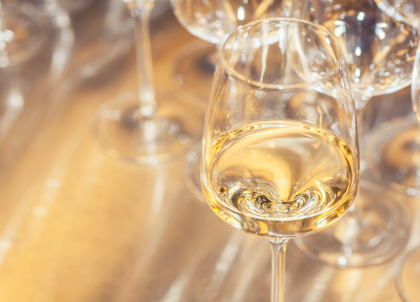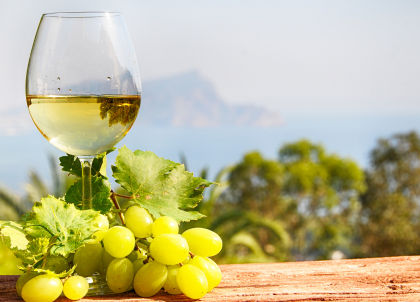- Log in to post comments
A Toast to White Wine
Member Favorites & Industry Insights for National White Wine Day
White wine may not always grab the spotlight, but its range—crisp and citrusy to rich and aromatic—makes it indispensable. In honor of National White Wine Day on August 4th, we’ve spotlighted USBG members: three have shared their favorite bottles, and several more contributed insightful commentary on white wine’s place in the industry and culture.
📅 What Is National White Wine Day?
Observed every August 4th in the U.S., National White Wine Day is a chance to celebrate the diversity, charm, and versatility of white wine.
While the day’s origin is unclear, one source credits wine enthusiast Jace Shoemaker-Galloway with creating it in 2014. There’s no official sponsor or governing body, but it has gained popularity over the last decade as a way to highlight white wine’s range and appeal.
🕰 A Brief History of White Wine
-
7500 BC, modern-day Iran: Archaeological evidence shows early grape fermentation began here.
-
Ancient Greece (~460 BC): Hippocrates, the "father of medicine," used white wine medicinally.
-
Roman Empire: Wine gained prestige, with white styles favored in warm seasons. Romans also popularized drinking wine seasonally—chilled in summer, warm in winter.
-
16th century onward: European colonists brought viticulture to the Americas, expanding white wine traditions into regions like Mexico, Chile, and Argentina.
-
18th–19th centuries: Champagne was perfected in France and became a luxury symbol; by the 20th century, wine production was transformed by technological advances, making white wine more accessible and varied than ever before.
Challenging Misconceptions
“First, taste is personal. People like what they like and should drink what they like. No shade or judgment. But my observations:
From wine professionals, yes, white wine is respected. From the general wine consumers, no. As people begin to explore wine more, they see the nuance and complexity that the category has to offer, but when folks are just starting out, white wine is often seen as cheap and cheerful.
In general from customers and guests, red wine seems to be what 'serious' people should drink. White wine is often dismissed as sweet or simple or unsophisticated. Even with people who do like white wine, I get the 'anything but Chardonnay' crowd—who don’t really know what they’re drinking and happily enjoy a Chablis or glass of Champagne. And don’t get me started on Riesling, and how many people think it’s all sticky sweet.” — Jess Helfand, Wine Educator, Napa Valley Wine Academy
 Liz Pirnat, USBG Board Member and Head Spirits Educator at Napa Valley Wine Academy, adds: “Biggest misconceptions with white wine and consumers are if it's Chardonnay it's all oaky. Or all white wine is simple, there are no outstanding quality white wines.”
Liz Pirnat, USBG Board Member and Head Spirits Educator at Napa Valley Wine Academy, adds: “Biggest misconceptions with white wine and consumers are if it's Chardonnay it's all oaky. Or all white wine is simple, there are no outstanding quality white wines.”
“The pendulum is starting to swing back toward white wines. On a recent trip to Austria, quite a number of winemakers discussed changing out many of their black grape plantings for white grapes.” — Stephen Staples, Instructional Designer & Certified WSET Beer Instructor, Napa Valley Wine Academy
“People don’t taste enough, so bad memories of overly sweet or too bitter (acidic) white wine stay in their mind. They might also order wine just with dinner and don’t feel like having white wine with meats—other than fish—because their assumption is that it would be ‘too light.’”
— Mirva Swartz, Director of Customer Success Operations, Napa Valley Wine Academy
Ryan McCann, USBG OKC President and Manager at Tiny Bubbles Wine Bar, highlights Riesling—especially from New York’s Finger Lakes region—as a style more people should explore.
“I typically hear a lot of push back on Rieslings, because what most people know are the bigger mass-marketed Rieslings. What I love about Finger Lake Rieslings is that they tend to have that high acid and zesty profile people love in a Sauvignon Blanc, but with more stone fruit and minerality.”
When helping guests who say they don’t like white wine, Ryan leans on thoughtful, personalized questions:
“What do you typically drink?” “What is it about white wine that you don’t like?” “Do you tend to like things on the sweet or dry side?” “What are you planning on eating with your wine?” With this information, he adds, “the experience can be more catered to the consumer, rather than trying to get them to like something that you like or what is popular at the moment.”
🧠 A Closer Look: The Role of White Wine in a Beverage Program
Jamal Hassan, Owner of Ice Cold Co. and USBG Oregon member, shares an insightful perspective on white wine’s critical role behind the scenes:
“When building a wine list or curating pairings, white wine is essential. It’s the connective tissue between the menu and the guest—offering flexibility and nuance that complement a variety of dishes. It’s not just about acid and seafood pairings—though acid matters—it’s about building a wine section that invites people into the experience, whether they’re deep into natural wine or just dipping a toe in. White wine is where I can take risks that feel approachable. Skin-contact Pinot Gris? That’s going to start more conversations than another brooding Cab. It’s also the category where you can sneak in more experimental, biodynamic, or low-intervention bottles without scaring off the table.”
On what white wine does better than red or rosé, Jamal adds:
“White wines tell the truth faster. You can’t hide behind new oak or extraction—you have to let the fruit, the acid, the soil—all of it—speak. That immediacy is something red and rosé rarely deliver with the same clarity. White wine also plays well with contradiction. It can be both nervy and lush, restrained and wild. Red wine often wants to be the star of the show; white wine is confident playing rhythm, but when you give it a solo, it’ll absolutely steal the set.”
I think white wine is better at balancing rich foods with a high fat content. A red or rosé would taste flat and/or bitter if paired with (for example) a piece of fish in a Meunière Sauce; whereas a crisp, dry white would enhance the subtle flavors of both the fish and the sauce, allowing both the dish and the wine to shine. I also think white wines highlight floral and citrus notes more robustly than rosés, and that the minerality of a white wine creates a more complex palate experience. It is common to assume that red wines are the most complex choices on a wine menu, but I believe the vast variety of white wine grapes available creates the opportunity to pair it with almost any dish— Augustina Elizabeth, USBG WA Member and SpellCraftPDX Founder.
🥂 Types of White Wine
From crisp and citrusy to rich and full-bodied, white wines come in a wide range of styles. Here are a few classic types:
-
Chardonnay – Can be creamy and oaky or fresh and unoaked, depending on the winemaking style.
-
Sauvignon Blanc – Zippy and herbaceous, with notes of lime, green apple, or tropical fruit.
-
Riesling – Ranges from bone-dry to sweet, known for bright acidity and aromatic complexity.
-
Pinot Grigio / Pinot Gris – Light-bodied and refreshing, often with pear and citrus notes.
-
Viognier – Fuller-bodied with stone fruit and floral aromas; often used in bold pairings.
-
Albariño – A coastal white from Spain, known for salinity and bright citrus.
-
Gewürztraminer – Aromatic and often off-dry, with notes of lychee, rose, and spice.
-
Grüner Veltliner – Austria’s signature white; dry, peppery, and great with food.
🍾 White Wine Bottles Our Members Recommend
Here’s a starting list of favorite white wines from USBG members:
Frederic Yarm – USBG Boston Member and Bartender at the C-Side Bar
Oyster River Wine Growers' Morphos Petillant Naturel
Produced in Maine using Cayuga and Seyval Blanc grapes from New York's Finger Lakes region. Frederic loves the pétillant naturel style—spontaneous fermentation bottled early to create frizzante carbonation. The wine features apricot, peach, and pear notes with wild yeast-driven acidity, zippiness, complexity, and a hint of breadiness, making it great for food or solo sipping. Notably, it uses hybrid grapes that would be shunned in the EU but produce delicious results.
Roohi Rustum – USBG Cleveland Member and Advisor at American Business Immigration Coalition (ABIC)
Domaine Tessier, Porte Dorée (Cour Cheverny, Loire Valley, France)
This Romorantin-based white wine is complex and impossible to categorize easily—reminiscent of Chenin, Chardonnay, and Sauvignon Blanc at once. Domaine Tessier is a small estate planted in 1961, with vines 40-90 years old. The wine’s flavors include yuzu, blanched almonds, toasted yellow pears, honeysuckle, rich custard, and lemon curd, paired with brisk acidity that cuts through rich foods beautifully. Delightful and lingering, it's a standout that deserves attention.
Laura Tamayo – USBG Tampa Bay Member and Educator at Napa Valley Wine Academy
Abbazia di Novacella Kerner (Alto-Adige, Italy)
This wine dances across the palate with floral notes, citrus, and peach. A surprising hint of sweet and savory herbs adds complexity. The palate shows vibrant acidity with rounded edges, making it both lively and balanced.
Liz Pirnat – USBG Board Member and Head Spirits Educator at Napa Valley Wine Academy
Toad Hollow Chardonnay (Mendocino County, California)
While many knock Chardonnay, this unoaked California Chardonnay from a cooler climate offers refreshing acidity, perfect for a hot summer day. Lovely apple and floral aromas mingle with a hint of cream from malolactic fermentation, creating a balanced and inviting wine.
Whether you’re sipping a crisp glass after work, building a wine list that encourages discovery, or challenging old assumptions in your beverage program—white wine has a story to tell. This National White Wine Day, we raise a glass to the USBG members who continue to lead with knowledge, curiosity, and taste. Cheers to the wines that surprise us, the makers who inspire us, and the community that keeps elevating the conversation.
This is not a sponsored post.


